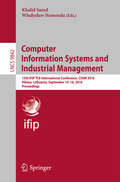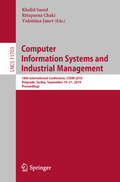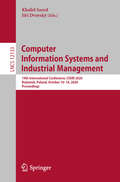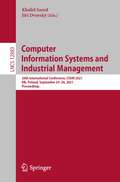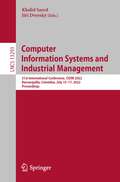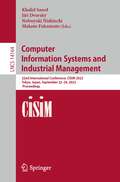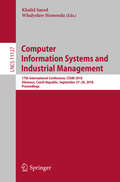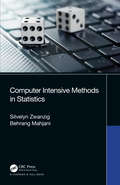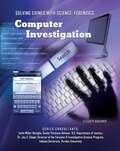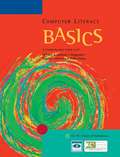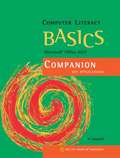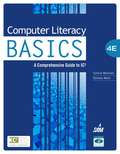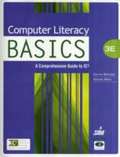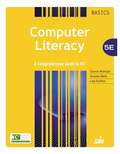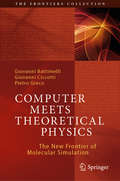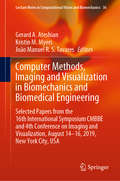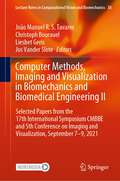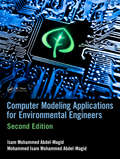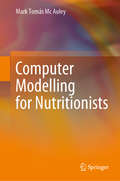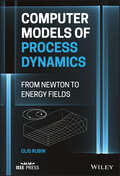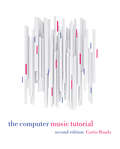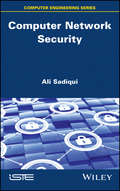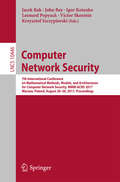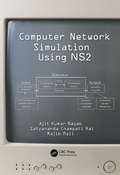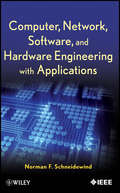- Table View
- List View
Computer Information Systems and Industrial Management: 15th IFIP TC8 International Conference, CISIM 2016, Vilnius, Lithuania, September 14-16, 2016, Proceedings (Lecture Notes in Computer Science #9842)
by Władysław Homenda Khalid SaeedThis book constitutes the refereed proceedings of the 11th International Conference on Computer Information Systems and Industrial Management, CISIM 2012, held in Venice, Italy, in September 2012. The 35 revised full papers presented together with 2 keynote talks were carefully reviewed and selected from 80 submissions. The papers are organized in topical sections on security, access control and intrusion detection; pattern recognition and image processing; biometric applications; algorithms and data management; networking; and system models and risk assessment.
Computer Information Systems and Industrial Management: 18th International Conference, CISIM 2019, Belgrade, Serbia, September 19–21, 2019, Proceedings (Lecture Notes in Computer Science #11703)
by Khalid Saeed Rituparna Chaki Valentina JanevThis book constitutes the proceedings of the 18th International Conference on Computer Information Systems and Industrial Management Applications, CISIM 2019, held in Belgrade, Serbia, in September 2019. The 43 full papers presented together with 3 abstracts of keynotes were carefully reviewed and selected from 70 submissions. The main topics covered by the chapters in this book are biometrics, security systems, multimedia, classification and clustering, industrial management. Besides these, the reader will find interesting papers on computer information systems as applied to wireless networks, computer graphics, and intelligent systems. The papers are organized in the following topical sections: biometrics and pattern recognition applications; computer information systems; industrial management and other applications; machine learning and high performance computing; modelling and optimization; various aspects of computer security.
Computer Information Systems and Industrial Management: 19th International Conference, CISIM 2020, Bialystok, Poland, October 16–18, 2020, Proceedings (Lecture Notes in Computer Science #12133)
by Khalid Saeed Jiří DvorskýThis book constitutes the proceedings of the 19th International Conference on Computer Information Systems and Industrial Management Applications, CISIM 2020, held in Bialystok, Poland, in October 2020. Due to the COVID-19 pandemic the conference has been postponed to October 2020. The 40 full papers presented together with 5 abstracts of keynotes were carefully reviewed and selected from 62 submissions. The main topics covered by the chapters in this book are biometrics, security systems, multimedia, classification and clustering, industrial management. Besides these, the reader will find interesting papers on computer information systems as applied to wireless networks, computer graphics, and intelligent systems. The papers are organized in the following topical sections: biometrics and pattern recognition applications; computer information systems and security; industrial management and other applications; machine learning and high performance computing; modelling and optimization.
Computer Information Systems and Industrial Management: 20th International Conference, CISIM 2021, Ełk, Poland, September 24–26, 2021, Proceedings (Lecture Notes in Computer Science #12883)
by Khalid Saeed Jiří DvorskýThis book constitutes the proceedings of the 20th International Conference on Computer Information Systems and Industrial Management Applications, CISIM 2021, held in Ełk, Poland, September 24–26, 2021. The 38 papers presented together with 1 invited speech and 3 abstracts of keynotes were carefully reviewed and selected from 69 submissions. The main topics covered by the chapters in this book are mobile and pervasive computing, machine learning, high performance computing, image processing, industrial management. Additionally, the reader will find interesting papers on computer information systems, biometrics, security systems, and sensor network service. The contributions are organized in the following topical sections: biometrics and pattern recognition applications; computer information systems and security; industrial management and other applications; machine learning and artificial neural networks; modelling and optimization, and others.Chapter 24 "A first step towards automated species recognition from camera trap images of mammals using AI in a European temperate forest" is published open access under a CC BY license (Creative Commons Attribution 4.0 International License).
Computer Information Systems and Industrial Management: 21st International Conference, CISIM 2022, Barranquilla, Colombia, July 15–17, 2022, Proceedings (Lecture Notes in Computer Science #13293)
by Khalid Saeed Jiří DvorskýThis book constitutes the proceedings of the 21st International Conference on Computer Information Systems and Industrial Management Applications, CISIM 2022, held in Barranquilla, Colombia, in July 2022. The 28 papers presented together with 3 keynotes were carefully reviewed and selected from 68 submissions. The main topics covered by the chapters in this book are biometrics, security systems, multimedia, classification and clustering, and industrial management as well as interesting papers on computer information systems as applied to wireless networks, computer graphics, and intelligent systems.
Computer Information Systems and Industrial Management: 22nd International Conference, CISIM 2023, Tokyo, Japan, September 22–24, 2023, Proceedings (Lecture Notes in Computer Science #14164)
by Khalid Saeed Jiří Dvorský Nobuyuki Nishiuchi Makoto FukumotoThis book constitutes the proceedings of the 22nd International Conference on Computer Information Systems and Industrial Management, CISIM 2023, held in Tokio, Japan, during September 22-24, 2023. The 36 papers presented in this book were carefully reviewed and selected from 77 submissions. They were organized in topical sections as follows: biometrics and pattern recognition applications; computer information systems and security; industrial management and other applications; machine learning and artificial neural networks; modelling and optimization; wellbeing and affective engineering; and machine learning using biometric data and kansei data.
Computer Information Systems and Industrial Management: 17th International Conference, CISIM 2018, Olomouc, Czech Republic, September 27-29, 2018, Proceedings (Lecture Notes in Computer Science #11127)
by Khalid Saeed Władysław HomendaThis book constitutes the proceedings of the 17th International Conference on Computer Information Systems and Industrial Management Applications, CISIM 2018, held in Olomouc, Czech Republic, in September 2018. The 42 full papers presented together with 4 keynotes were carefully reviewed and selected from 69 submissions. The main topics covered by the chapters in this book are biometrics, security systems, multimedia, classification and clustering, and industrial management. Besides these, the reader will find interesting papers on computer information systems as applied to wireless networks, computer graphics, and intelligent systems. The papers are organized in the following topical sections: biometrics and pattern recognition applications; computer information systems; industrial management and other applications; machine learning and high performance computing; modelling and optimization; and various aspects of computer security.
Computer Intensive Methods in Statistics
by Silvelyn Zwanzig Behrang MahjaniThis textbook gives an overview of statistical methods that have been developed during the last years due to increasing computer use, including random number generators, Monte Carlo methods, Markov Chain Monte Carlo (MCMC) methods, Bootstrap, EM algorithms, SIMEX, variable selection, density estimators, kernel estimators, orthogonal and local polynomial estimators, wavelet estimators, splines, and model assessment. Computer Intensive Methods in Statistics is written for students at graduate level, but can also be used by practitioners. Features Presents the main ideas of computer-intensive statistical methods Gives the algorithms for all the methods Uses various plots and illustrations for explaining the main ideas Features the theoretical backgrounds of the main methods. Includes R codes for the methods and examples Silvelyn Zwanzig is an Associate Professor for Mathematical Statistics at Uppsala University. She studied Mathematics at the Humboldt- University in Berlin. Before coming to Sweden, she was Assistant Professor at the University of Hamburg in Germany. She received her Ph.D. in Mathematics at the Academy of Sciences of the GDR. Since 1991, she has taught Statistics for undergraduate and graduate students. Her research interests have moved from theoretical statistics to computer intensive statistics. Behrang Mahjani is a postdoctoral fellow with a Ph.D. in Scientific Computing with a focus on Computational Statistics, from Uppsala University, Sweden. He joined the Seaver Autism Center for Research and Treatment at the Icahn School of Medicine at Mount Sinai, New York, in September 2017 and was formerly a postdoctoral fellow at the Karolinska Institutet, Stockholm, Sweden. His research is focused on solving large-scale problems through statistical and computational methods.
Computer Investigation (Solving Crimes With Science: Forensics #12)
by Elizabeth BauchnerThe digital age we entered in the twenty-first century has rapidly become an age of digital crime. Cybercrimes like spoofing, phishing, and hacking are on the rise, and computer forensic technicians are on the case. Even "traditional" crimes like murder, fraud, and child abuse can be both facilitated by computers--and solved through computer investigation. Computer Investigation helps readers understand how cybercrimes are committed, and how investigators help solve them and bring the perpetrators to justice. Readers will also gain a few tips for protecting themselves online and protecting their computers from intrusions and hacks.
Computer Literacy Basics: A Comprehensive Guide to IC3
by Ann Ambrose Marly Bergerud Donald Busche Connie Morrison Dolores Wells-PusinsComputer Literacy BASICS provides an introduction to computer technology and concepts. This text maps to the IC3 standards and is organized into three key components: Computing Fundamentals, Key Applications, and Living Online. It provides thorough instruction on the various uses of the computer, important accessories, networking principles and covers key applications such as word processing, spreadsheets, and presentation applications. In addition, Computer Literacy BASICS covers e-mail and Internet principles such as managing e-mail and contacts, searching for a topic online, and how computers affect every day life. Strong end-of-chapter exercises and review material reinforce important topics covered in the lesson and allow students to demonstrate their knowledge of the material.
Computer Literacy Basics: Microsoft Office 2007 Companion
by Jennifer T. CampbellComputer Literacy BASICS: Microsoft Office 2007 Companion is designed to accompany Computer Literacy BASICS, Second Edition, providing updated coverage on Office 2007. Step-by-step instructions provide students with an overview of the Office 2007 software and will help them gain the skills necessary to pass the IC3 certification exam.
Computer Literacy Basics: A Comprehensive Guide to IC3
by Connie Morrison Dolores WellsCOMPUTER LITERACY BASICS: A COMPREHENSIVE GUIDE TO IC3 covers Computing Fundamentals, Key Applications, and Living Online - everything your students need to pass the IC3 exam, and finish the course as confident computer users.
Computer Literacy BASICS: A Comprehensive Guide to IC3
by Connie Morrison Dolores WellsBring your computer literacy course back to the BASICS. COMPUTER LITERACY BASICS: A COMPREHENSIVE GUIDE TO IC3 provides an introduction to computer concepts and skills, which maps to the newest Computing Core Certification (IC3) standards. Designed with new learners in mind, this text covers Computing Fundamentals, Key Applications, and Living Online - everything your students need to ace the IC3 exam, and finish the course as confident computer users.
Computer Literacy Basics: A Comprehensive Guide to IC³
by Connie Morrison Dolores Wells Lisa RuffoloBring your computer literacy course back to the BASICS. COMPUTER LITERACY BASICS: A COMPREHENSIVE GUIDE TO IC3 provides an introduction to computer concepts and skills, which maps to the newest Computing Core Certification (IC3) standards. Designed with new learners in mind, this text covers Computing Fundamentals, Key Applications, and Living Online - everything students need to pass the IC3 exam, and finish the course as confident computer users.
Computer Meets Theoretical Physics: The New Frontier of Molecular Simulation (The Frontiers Collection)
by Giovanni Battimelli Giovanni Ciccotti Pietro GrecoThis book provides a vivid account of the early history of molecular simulation, a new frontier for our understanding of matter that was opened when the demands of theoretical physicists were met by the availability of the modern computers. Since their inception, electronic computers have enormously increased their performance, thus making possible the unprecedented technological revolution that characterizes our present times. This obvious technological advancement has brought with it a silent scientific revolution in the practice of theoretical physics. In particular, in the physics of matter it has opened up a direct route from the microscopic physical laws to observable phenomena. One can now study the time evolution of systems composed of millions of molecules, and simulate the behaviour of macroscopic materials and actually predict their properties. Molecular simulation has provided a new theoretical and conceptual tool that physicists could only dream of when the foundations of statistical mechanics were laid. Molecular simulation has undergone impressive development, both in the size of the scientific community involved and in the range and scope of its applications. It has become the ubiquitous workhorse for investigating the nature of complex condensed matter systems in physics, chemistry, materials and the life sciences. Yet these developments remain largely unknown outside the inner circles of practitioners, and they have so far never been described for a wider public. The main objective of this book is therefore to offer a reasonably comprehensive reconstruction of the early history of molecular simulation addressed to an audience of both scientists and interested non-scientists, describing the scientific and personal trajectories of the main protagonists and discussing the deep conceptual innovations that their work produced.
Computer Methods, Imaging and Visualization in Biomechanics and Biomedical Engineering: Selected Papers from the 16th International Symposium CMBBE and 4th Conference on Imaging and Visualization, August 14-16, 2019, New York City, USA (Lecture Notes in Computational Vision and Biomechanics #36)
by João Manuel R. S. Tavares Gerard A. Ateshian Kristin M. MyersThis book gathers selected, extended and revised contributions to the 16th International Symposium on Computer Methods in Biomechanics and Biomedical Engineering, and the 4th Conference on Imaging and Visualization (CMBBE 2019), held on August 14-16, 2019, in New York City, USA. It reports on cutting-edge models and algorithms for studying various tissues and organs in normal and pathological conditions; innovative imaging and visualization techniques; and the latest diagnostic tools. Further topics addressed include: numerical methods, machine learning approaches, FEM models, and high-resolution imaging and real-time visualization methods applied for biomedical purposes. Given the scope of its coverage, the book provides graduate students and researchers with a timely and insightful snapshot of the latest research and current challenges in biomedical engineering, computational biomechanics and biological imaging, as well as a source of inspiration for future research and cross-disciplinary collaborations.
Computer Methods, Imaging and Visualization in Biomechanics and Biomedical Engineering II: Selected Papers from the 17th International Symposium CMBBE and 5th Conference on Imaging and Visualization, September 7-9, 2021 (Lecture Notes in Computational Vision and Biomechanics #38)
by João Manuel R. S. Tavares Christoph Bourauel Liesbet Geris Jos Vander SloteThis book gathers selected, extended and revised contributions to the 17th International Symposium on Computer Methods in Biomechanics and Biomedical Engineering and the 5th Conference on Imaging and Visualization (CMBBE 2021), held online on September 7-9, 2021, from Bonn, Germany. It reports on cutting-edge models, algorithms and imaging techniques for studying cells, tissues and organs in normal and pathological conditions. It covers numerical and machine learning methods, finite element modeling and virtual reality techniques, applied to understand biomechanics of movement, fluid and soft tissue biomechanics. It also reports on related advances in rehabilitation, surgery and diagnosis. All in all, this book offers a timely snapshot of the latest research and current challenges at the interface between biomedical engineering, computational biomechanics and biological imaging. Thus, it is expected to provide a source of inspiration for future research and cross-disciplinary collaborations.
Computer Modeling Applications for Environmental Engineers
by Isam Mohammed Abdel-Magid Ahmed Mohammed Isam Mohammed Abdel-MagidComputer Modeling Applications for Environmental Engineers in its second edition incorporates changes and introduces new concepts using Visual Basic.NET, a programming language chosen for its ease of comprehensive usage. This book offers a complete understanding of the basic principles of environmental engineering and integrates new sections that address Noise Pollution and Abatement and municipal solid-waste problem solving, financing of waste facilities, and the engineering of treatment methods that address sanitary landfill, biochemical processes, and combustion and energy recovery. Its practical approach serves to aid in the teaching of environmental engineering unit operations and processes design and demonstrates effective problem-solving practices that facilitate self-teaching. A vital reference for students and professional sanitary and environmental engineers this work also serves as a stand-alone problem-solving text with well-defined, real-work examples and explanations.
Computer Modelling for Nutritionists
by Mark Tomás Mc AuleyThis book draws on Mark Mc Auley’s wealth of experience to provide an intuitive step-by-step guide to the modelling process. It also provides case studies detailing the creation of biological process models. Mark Mc Auley has over 15 years’ experience of applying computing to challenges in bioscience. Currently he is employed as a Senior Lecturer in Chemical Engineering at the University of Chester. He has published widely on the use of computer modelling in nutrition and uses computer modelling to both enhance and enrich the learning experience of the students that he teaches. He has taught computer modelling to individuals at a wide variety of levels and from different backgrounds, from undergraduate nutrition students to PhD and medical students.
Computer Models of Process Dynamics: From Newton to Energy Fields
by Olis Harold RubinCOMPUTER MODELS OF PROCESS DYNAMICS Comprehensive overview of techniques for describing physical phenomena by means of computer models that are determined by mathematical analysis Computer Models of Process Dynamics covers everything required to do computer based mathematical modeling of dynamic systems, including an introduction to a scientific language, its use to program essential operations, and methods to approximate the integration of continuous signals. From a practical standpoint, readers will learn how to build computer models that simulate differential equations. They are also shown how to model physical objects of increasing complexity, where the most complex objects are simulated by finite element models, and how to follow a formal procedure in order to build a valid computer model. To aid in reader comprehension, a series of case studies is presented that covers myriad different topics to provide a view of the challenges that fall within this discipline. The book concludes with a discussion of how computer models are used in an engineering project where the readers would operate in a team environment. Other topics covered in Computer Models of Process Dynamics include: Computer hardware and software, covering algebraic expressions, math functions, computation loops, decision-making, graphics, and user-defined functions Creative thinking and scientific theories, covering the Ancients, the Renaissance, Galileo, Newton, electricity and magnetism, and newer sciences Uncertainty and softer science, covering random number generators, statistical analysis of data, the method of least squares, and state/velocity estimators Flight simulators, covering the motion of an aircraft, the equations of motion, short period pitching motion, and phugoid motion Established engineers and programmers, along with students and academics in related programs of study, can harness the comprehensive information in Computer Models of Process Dynamics to gain mastery over the subject and be ready to use their knowledge in many practical applications in the field.
The Computer Music Tutorial, second edition
by Curtis RoadsExpanded, updated, and fully revised—the definitive introduction to electronic music is ready for new generations of students.Essential and state-of-the-art, The Computer Music Tutorial, second edition is a singular text that introduces computer and electronic music, explains its motivations, and puts topics into context. Curtis Roads&’s step-by-step presentation orients musicians, engineers, scientists, and anyone else new to computer and electronic music.The new edition continues to be the definitive tutorial on all aspects of computer music, including digital audio, signal processing, musical input devices, performance software, editing systems, algorithmic composition, MIDI, and psychoacoustics, but the second edition also reflects the enormous growth of the field since the book&’s original publication in 1996. New chapters cover up-to-date topics like virtual analog, pulsar synthesis, concatenative synthesis, spectrum analysis by atomic decomposition, Open Sound Control, spectrum editors, and instrument and patch editors. Exhaustively referenced and cross-referenced, the second edition adds hundreds of new figures and references to the original charts, diagrams, screen images, and photographs in order to explain basic concepts and terms.FeaturesNew chapters: virtual analog, pulsar synthesis, concatenative synthesis, spectrum analysis by atomic decomposition, Open Sound Control, spectrum editors, instrument and patch editors, and an appendix on machine learningTwo thousand references support the book&’s descriptions and point readers to further studyMathematical notation and program code examples used only when necessaryTwenty-five years of classroom, seminar, and workshop use inform the pace and level of the material
Computer Network Security
by Ali SadiquiDeveloped in collaboration with a training and certification team from Cisco, Computer Network Security is an exploration of the state-of-the-art and good practices in setting up a secure computer system. Concrete examples are offered in each chapter, to help the reader to master the concept and apply the security configuration. This book is intended for students preparing for the CCNA Security Exam (210-260 IINS) ? whether at professional training centers, technical faculties, or training centers associated with the "Cisco Academy" program. It is also relevant to anyone interested in computer security, be they professionals in this field or users who want to identify the threats and vulnerabilities of a network to ensure better security.
Computer Network Security: 7th International Conference on Mathematical Methods, Models, and Architectures for Computer Network Security, MMM-ACNS 2017, Warsaw, Poland, August 28-30, 2017, Proceedings (Lecture Notes in Computer Science #10446)
by Krzysztof Szczypiorski Jacek Rak John Bay Igor Kotenko Leonard Popyack Victor SkorminThis book presents the refereed proceedings of the International Workshop on Mathematical Methods, Models, and Architectures for Network Security Systems, MMM-ACNS 2001, held in St. Petersburg in May 2001. The 24 revised full papers presented together with five invited contributions were carefully reviewed and selected from 36 submissions. The papers are organized in topical sections on network security systems: foundations, models and architectures; intrusion detection: foundations and models; access control, authentication, and authorization; and cryptography and steganography: mathematical basis, protocols, and applied methods.
Computer Network Simulation Using NS2
by Ajit Kumar Nayak Satyananda Champati Rai Rajib MallComputer Network Simulations Using NS2 provides a solid foundation of computer networking knowledge and skills, covering everything from simple operating system commands to the analysis of complex network performance metrics. The book begins with a discussion of the evolution of data communication techniques and the fundamental issues associated with performance evaluation. After presenting a preliminary overview of simulation and other performance evaluation techniques, the authors: Describe a number of computer network protocols and TCP/IP and OSI models, highlighting the networking devices used Explain a socket and its use in network programming, fostering the development of network applications using C and socket API Introduce the NS2 network simulator, exhibiting its internal architecture, constituent software packages, and installation in different operating systems Delve into simulation using NS2, elaborating on the use of Tcl and OTcl scripts as well as AWK scripting and plotting with Gnuplot Show how to simulate wired and wireless network protocols step by step, layer by layer Explore the idea of simulating very large networks, identifying the challenges associated with measuring and graphing the various network parameters Include nearly 90 example programs, scripts, and outputs, along with several exercises requiring application of the theory and programming Computer Network Simulations Using NS2 emphasizes the implementation and simulation of real-world computer network protocols, affording readers with valuable opportunities for hands-on practice while instilling a deeper understanding of how computer network protocols work.
Computer, Network, Software, and Hardware Engineering with Applications
by Norman F. SchneidewindThere are many books on computers, networks, and software engineering but none that integrate the three with applications. Integration is important because, increasingly, software dominates the performance, reliability, maintainability, and availability of complex computer and systems. Books on software engineering typically portray software as if it exists in a vacuum with no relationship to the wider system. This is wrong because a system is more than software. It is comprised of people, organizations, processes, hardware, and software. All of these components must be considered in an integrative fashion when designing systems. On the other hand, books on computers and networks do not demonstrate a deep understanding of the intricacies of developing software. In this book you will learn, for example, how to quantitatively analyze the performance, reliability, maintainability, and availability of computers, networks, and software in relation to the total system. Furthermore, you will learn how to evaluate and mitigate the risk of deploying integrated systems. You will learn how to apply many models dealing with the optimization of systems. Numerous quantitative examples are provided to help you understand and interpret model results. This book can be used as a first year graduate course in computer, network, and software engineering; as an on-the-job reference for computer, network, and software engineers; and as a reference for these disciplines.
